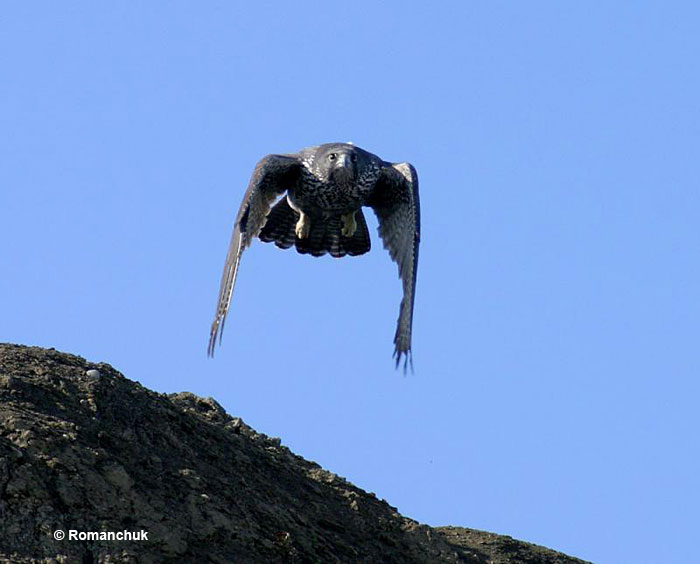The Gyrfalcon (Falco rusticolus) is a big, hefty falcon mottled with small dark markings. It can be mostly white, pale gray, or mostly dark-brown gray.
Birders usually need to visit Alaska or other northern regions to see this rare raptor. However, while birding during the winter in open habitats in southern Canada and the northern USA, you might get lucky and find one of these special falcons.
On this page
Identification
The Gyrfalcon is a big and robust falcon around the same size as a Red-tailed Hawk. On average, this raptor is 22 inches long, has a four-foot wingspan, and weighs 3.1 pounds.
Like many other raptors, male Gyrfalcons are a bit smaller than females. They usually weigh 1.75 to 3 pounds, while females can weigh 2.1 to 4.6 pounds.
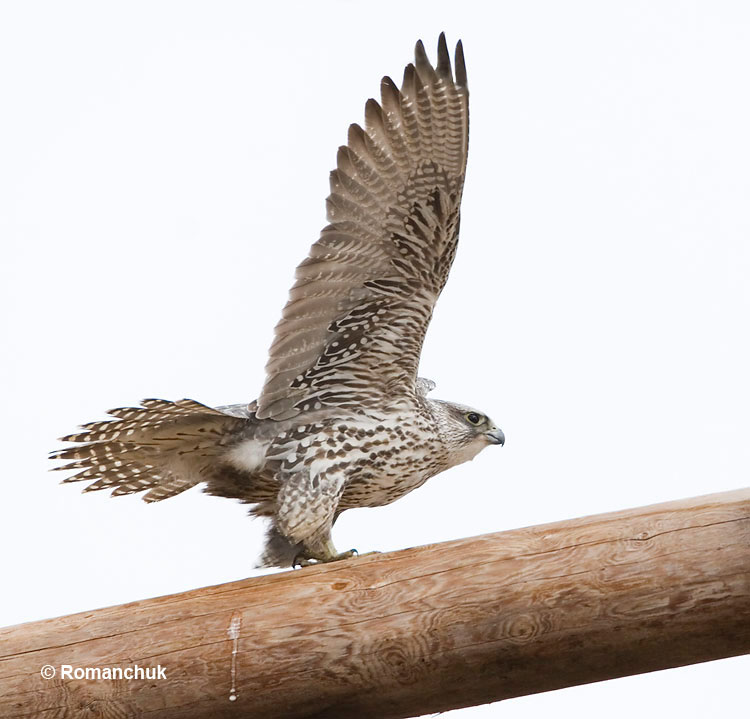
This species has three main types of plumage: white, gray, and dark, blackish-brown.
White Gyrfalcons mostly breed in northern Greenland and are bone white with varying degrees of black spotting on their upperparts. Gray Gyrfalcons have gray upperparts with white edging to their feathers, small dark markings on their head, and gray barring on white underparts.
They also have dark barring on their gray tail, and a faint mustache mark. Dark Gyrfalcons have blackish-brown upperparts, a dark hood, and mottled dark-brown underparts. They also have dark barring on their dark brown tail.
Juvenile Gyrfalcons look like paler, washed-out versions of adult birds and can have a more streaked appearance on their underparts.
In all plumages, this falcon species has a long tail, and long, rather broad wings.
Vocalizations
The Gyrfalcon has a raspy sounding call that it occasionally repeats a few times in a row. It sounds like “renh renh renh renh reh”.
Food
Gyrfalcons feed on a variety of birds and small mammals. On their breeding grounds, they catch a lot of ptarmigans and grouse but can also catch many ducks, shorebirds, and even small birds like Snow Buntings.
When the opportunity presents itself, this top predator can also prey on jaegers, gulls, hawks, Short-eared Owls, and even ravens!
They also catch small mammals, especially young Arctic Hares, ground squirrels, and lemmings. Whether hunting birds or mammals, they usually catch their prey on the ground, or drive it to the ground and kill it there.
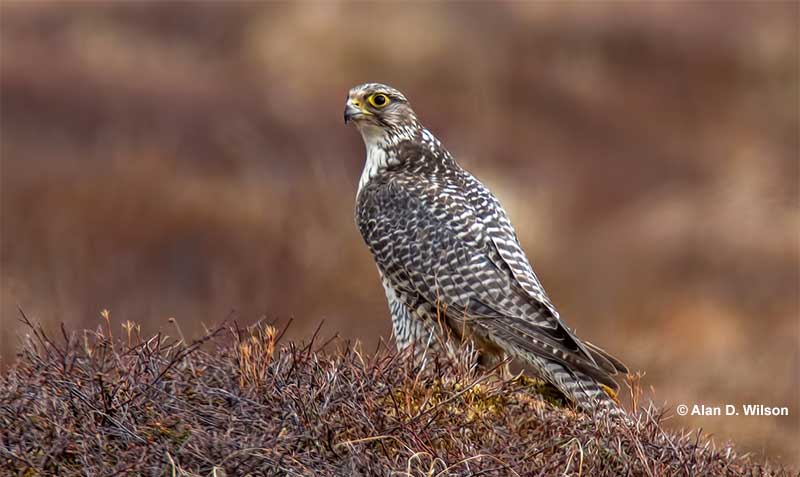
These big falcons hunt in a few different ways. They can watch for prey from a cliff or other elevated perch, fly low over the ground hoping to surprise prey, or look for animals during soaring flight.
When a Gyrfalcon spots a ptarmigan or other potential prey item, it quickly flies low over the ground towards its target, using the terrain for concealment so it can surprise the animal. If the bird sees the Gyrfalcon and takes flight, the falcon can pursue the bird and keep it in the air until the prey gets too tired to fly.
Related: What do falcons symbolize?
After breeding, these falcons also hunt from sea ice to catch murres, gulls, and other seabirds.
Nesting and Eggs
The Gyrfalcon doesn’t build its own nest. Instead, they usually use an old nest of a Common Raven, Golden Eagle, or Rough-legged Hawk. On occasion, they drive Common Ravens away from their nest to steal it, but they avoid Golden Eagles.
They typically use nests built on cliff ledges or rock outcroppings and can use the same nest year after year. If they can’t find an existing nest, a pair can nest on a bare ledge or on artificial structures. They often breed near seabird colonies or other good hunting grounds.
The female lays one to five red-brown or pale white eggs that are 2.2 inches long and weigh 2.1 ounces each.
Both sexes incubate the eggs, although the mother falcon does most of the incubation. The baby falcons hatch after 35 days and stay in the nest for around seven to eight weeks.
Both parents feed the nestlings, although the male brings all of the food for the first two to three weeks. For the first five weeks, plucked and partially dismembered ptarmigans are brought to the babies. After that time, they pluck the ptarmigans at the nest before giving the food to the nestlings.
The young Gyrfalcons fend for themselves four to six weeks after they leave the nest.
Current Situation
Gyrfalcons mostly live in high arctic and montane tundra habitats in Alaska, Canada, Greenland, Iceland, and Eurasia. In winter, some also migrate to wetlands, coastal areas, and other wide-open habitats with lots of birds to prey on in southern Canada and the northern USA.
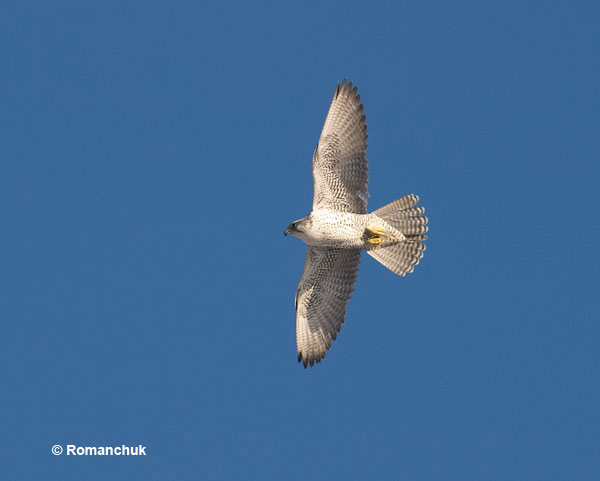
This species is listed as Least Concern in the IUCN Red List, but it is naturally rare and may have a small global population of 10,000 to 20,000 birds.
The Gyrfalcon has a stable population but some populations are affected by trapping for the falconry trade. In Russia, hundreds also die each year after getting accidentally caught in leg-hold traps set to catch ptarmigans and small mammals. However, as with many Arctic species, the biggest possible threat faced by the Gyrfalcon is climate change. Arctic ecosystems are drastically affected by a rapidly warming climate and this and other species may not be able to adapt quickly enough to survive the changes.
Facts
- This impressive falcon has been revered by people for thousands of years, especially for falconry. In Medieval Europe, it was reserved for nobility, and has been coveted as a trained hunter by rulers from the Middle east to eastern Asia for many centuries.
- Generations of Gyrfalcons can use the same ledge for nesting for a very long time. Carbon dating at one such nest from Greenland showed that it had been used by Gyrfalcons for at least 2,500 years!
- Some populations of this species are highly dependent on healthy populations of ptarmigans. In some places, when a pair of Gyrfalcons nest and raise young, they might catch anywhere from 150 to 200 ptarmigans!
- This species is the official bird of the Northwest Territories. It is also the official mascot for the United States Air Force Academy, and is depicted on the Icelandic crest.
- These falcons are highly adapted to cold weather. They bathe in water that melts on ice, and can feed on frozen pieces of ptarmigan.
Similar Species
The Gyrfalcon is a big, distinctive raptor. However, since size can be deceptive, it can be confused with a couple other similar falcon species.
Peregrine Falcon
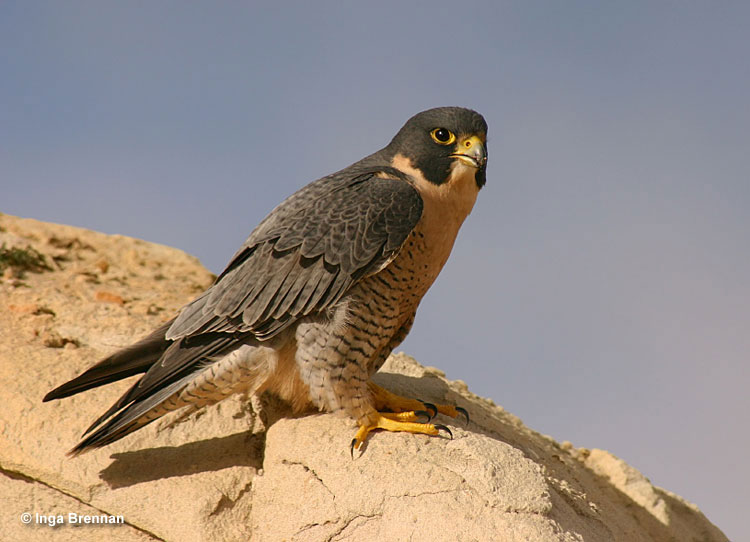
The Gyrfalcon doesn’t have the dark hood, pale breast, and barring on the belly shown by the adult Peregrine Falcon. Young Peregrine Falcons are often confused with Gyrfalcons but they have a more contrasting dark moustache mark and pale patch on their face.
Prairie Falcon
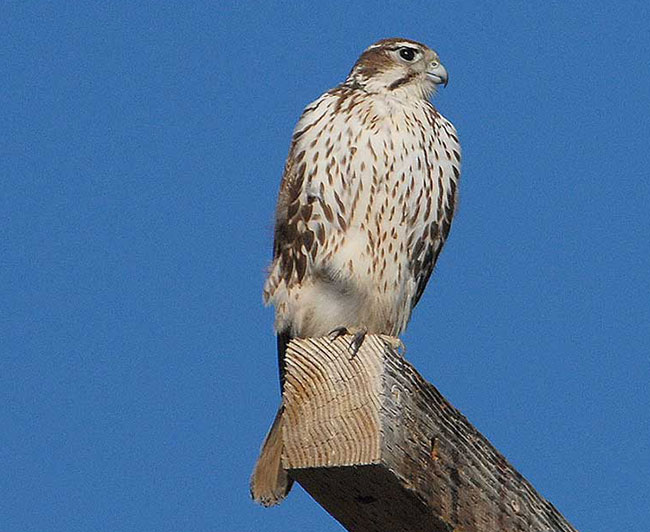
Photograph © USFWS
This bird’s pale plumage and sparse markings on its underparts can make it look like a Gyrfalcon. However, Gyrfalcons don’t have the Prairie Falcon’s distinctive white face patch and dark moustache mark. The Prairie Falcon also has contrasting black on its wing linings, a field mark never shown by the Gyrfalcon.
Frequently Asked Questions
Why is it called a Gyrfalcon?
It is called a Gyrfalcon because this name comes from an Old French term for this bird, “Gerfaucon”. This word means, “Vulture Falcon” and probably refers to its large size.
Are Gyrfalcons rare?
Yes, Gyrfalcons are naturally rare. Although they have a stable population, this species has low density populations that need distinct conditions and fairly large areas for breeding.
What is the difference between a falcon and a Gyrfalcon?
The difference between a falcon and a Gyrfalcon is that a Gyrfalcon is a type of falcon. It is the largest falcon species.
Where are Gyrfalcons found?
Gyrfalcons are found in Arctic and montane tundra habitats in far northern regions. Some birds also migrate to southern Canada, the northern USA, and northern China for the winter.

